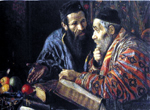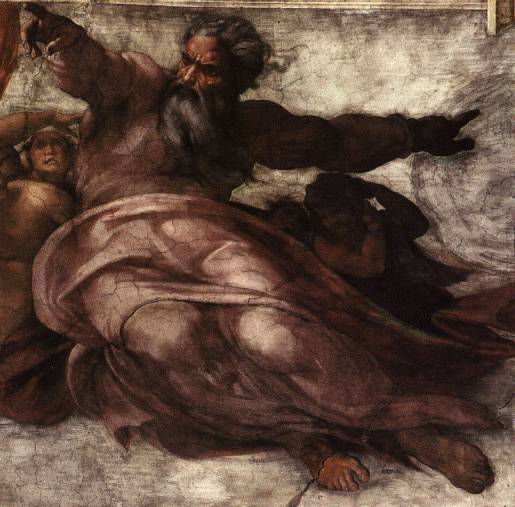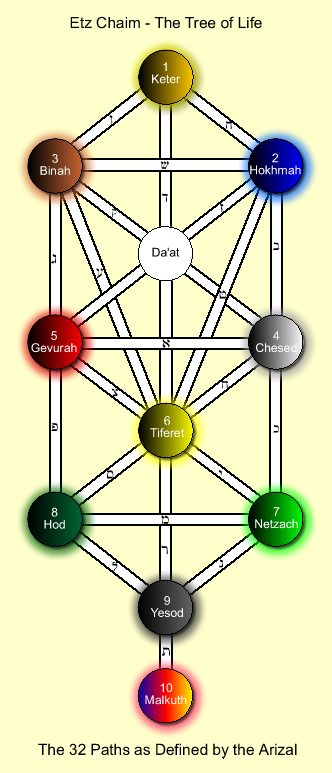


Before a grandson of the “holy Yehudi,” a zaddik of the seventh generation, a merchant brought a complaint against another who had opened a business next to him and reduced his profits. “Why,” asked the zaddik, “do you attach yourself so to the business by which you nourish yourself? What really matters is to pray to Him who nourishes and preserves! But perhaps you do not know where He dwells; now then, it is written, ‘Love thy fellow as one like thyself, I am the Lord.’ Only love him, your fellow, and wish that he too may have what he needs, - there, in this love, you will find the Lord.” (Ref. 1: Buber, p. 230)

Note to the student: We continue now with our discussion of this Hasidic anecdote. It now appears that it will run to yet a third installment, as the Ruach HaKodesh (Holy Spirit) has been generous in the dispensation of Its holy inspiration. Baruch HaShem!
The Emptiness of Modern Life
In our last installment we discussed the danger of becoming identified with one’s persona, the mask we wear at work or church or generally when in public. Every society exerts strong pressure on the individual to adopt and conform to its norms, values, ethics, laws and traditions. In the industrialized west, especially in the United States, which is so wrapped up in the "pursuit of happiness" (read that to mean wealth, status and power), it is virtual heresy to question these values and pursuits. The acquisition of ever greater sums of money and property, the attainment of celebrity status and display of ostentatious lifestyles, have become the outright if unstated goals of far too many Americans. (See Note 1 below) In a culture of conformity it is very difficult, if not dangerous, to stand apart, much less to stand over or against the mentality of the herd. On an unconscious level, such a person would be perceived as an indictment of the collective consciousness and therefore a threat to be eliminated. So almost everyone conforms.
But, as we discussed, such a life, dedicated almost entirely to the acquisition of material things in order to project an image of "success" and thereby elevate one’s ego and stature within the collective mentality is a spiritual cul-de-sac. Spiritual teachers in every culture and era have recognized this fact. It should come as no surprise, therefore, that one of the fundamental teachings of Hasidism is that one should free oneself of all unnecessary attachments to the material world and strive with all of one’s might instead to attach oneself to God. Thus we read:
"If one has love for something physical, then this physical thing becomes a vessel [that limits] his love. … But when one has love for the Infinite Being, then his love is clothed in the Infinite. Both the love and its vessel are then boundless." (Ref. 2: R. Dov Ber, Imrey Tzadikim, p. 19c, see Note 2)
In Jungian psychological terms, it is the freeing of oneself from the collective consciousness that constitutes the first step in the process of individuation. This setting free of oneself is marked by an attitude of indifference to what others think of the individual. What matters most becomes what one thinks of oneself in terms of the spiritual journey in which one develops one’s innate gifts and talents in service of a relationship with the Self (God). And so in our Hasidic anecdote we read:
"Why," asked the zaddik, "do you attach yourself so to the business by which you nourish yourself? What really matters is to pray to Him who nourishes and preserves!"
Who nourishes and preserves? God did not merely create the universe, winding it up like some clockmaker who then walked away. He also creates and sustains it continually.
"They all [all life forms including mankind] depend upon you, to feed them when they need it. You provide the food they gather, your open hand gives them their fill. Turn away your face and they panic; take back their breath and they die and revert to dust. Send out your breath and life begins; you renew the face of the earth." (Ps. 104:27-30)
"The most important thing to realize is that God created all and that He is all. … God’s influence never ceases. At every instant, He gives existence to His creation, to all the universes, to the heavenly chambers, and to all the angels. … We therefore say, ‘He forms light and creates darkness’, not ‘He formed light and created darkness.’ We say that God ‘creates’ in the present tense because every second He creates and gives existence to all that is." (Ref. 3: R. Levi Yitzchak of Berdichev, Kedushat Levi, Bereshit, p. 1, see Note 3)
What is this nourishment? How does it work, and what do we need to know about it? Look at the diagram of the Ten Holy Sefirot (Etz Chaim – Tree of Life).

The Creation of the World Through the Holy Sefirot
(Caveat to the student: make no mistake – all such discussions of the nature of the Godhead make use of symbols, metaphors and pronouns because the Divine Mind cannot be perceived or envisioned by the human mind. Do not take these symbols to be a literal description of the mind and body of God.)
The sages teach us that God created the world by speaking ten ma’amarot ("words"), or logoi (mishnah Tractate Avot). We see in the Holy Sefirot the ten words, each of which also has associated with it a name of God (not shown in the diagram). By means of these ten holy words God brought into being the four upper worlds of the Godhead and also, below the tenth Sefirot Malkuth ("Kingdom"), the lower world which we know as our universe and which is a reflection of the upper worlds. All active energy was concentrated in these words, which have been described as vessels, intellects, aspects, attributes, forces, voices, or even kings of the Divine Mind. The process by which each Holy Sefirah was emanated and filled with energy was sequential, from the top down in the form of a lightning bolt.
First, God’s light shone into the darkness of the primordial womb and created each of the Sefirot. But these vessels were empty, so God sent His light again into the void and filled the first Sefirah Keter ("Crown") with all the traits God had decided to bring into manifestation. This holy light filled the vessel until it reached its fill and overflowed much like a glass of wine. The light that overflowed from Keter then spilled into the second Sefirah Hokhmah ("Wisdom") and filled it until it too overflowed, spilling into the third Sefirah Binah ("Understanding"). This process of filling and overflowing continued until all the remaining Sefirot had come into existence and were completely filled with God’s holy Light — Chesed = "Loving-kindness," Gevurah/Din = "Power/Judgment," Tiferet/Rachamin = "Beauty/Compassion," Netzach = "Endurance/Victory/Life," Hod = "Majesty/Diminishment/Death," Yesod Ha-Olam/Tzaddik = "Foundation of the World/Righteous One," Malkhuth/Shekhinah/Knesset Y’srael = "Kingdom/God’s Presence/Community of Israel.
As we mentioned briefly above, this process of manifestation continued below
The great 18th century Kabbalist, Rabbi Moshe Chaim Luzzatto (1707 – 1746), known by his initials as the RaMCHaL, wrote:
"These Forces were the first things created, and they were arranged in various systems and placed in different domains. … The existence and state of being of the physical universe thus emanate from these highest Forces and are dependent upon them. Whatever exists in the physical world is a result of something that takes place among these Forces. This is true of both what existed in the beginning and what transpires with the passage of time. … The existence, state, arrangement, and other phenomena involving physical things in turn depend on what is transmitted and reflected to them by these Forces, following the essential nature of these physical entities." (Ref. 4: R. Moshe Chaim Luzzatto, Derech HaShem I:5:3)
About these forces, Gershom Scholem, the first great Kabbalah scholar of the modern era, said:"Ein – Sof is only seldom conceived of as energy or power. … However, the Sefiroth, while part of the divine essence (albeit as stages of His revelation, aspects of His nature through which He manifests Himself to us), are primarily bearers of His active and creative force. The word "forces" (koah), found so often in Kabbalistic writings, is not to be construed in the sense of the medieval distinction between actus and potentia: the Sefiroth are not merely potentialities, but are real, existent beings. They are hypostases that have become independent; charged with and emanating energy, they empower and advance the process by which God reveals Himself and makes His great name known." (Ref. 5: Gershom Scholem, pp. 159-160)
It is the Ten Sefirot of the holy Tree of Life that are the "Transcendental Forces" which are the root of everything that exists in the universe. Each represents an attribute or quality of God, and each is connected to one or more of the others by "paths" or "channels." It is through these channels that the Ten Sefirot communicate with and relate to one another within the four worlds of the Godhead. It is through these channels that each transmits its "influence." And it is through Yesod and Malkhuth that this life-sustaining influence is transmitted to our world. In our next installment we will discuss how God sustains His Creation through Shefa Ha-Berakhah ("Abundance of Blessing").
Baruch HaShem
Rebbe Yahoshua Nesher ben Yakov Leib (YaNYaL)
___________________________________
Notes
Note 1: A recent survey of elementary and middle school students revealed that nearly 50% of them stated that their life goal is to become rich and famous.
Note 2: Rabbi Dov Ber of Mezricher, the Great Maggid (1704 – 1772). The successor to the Ba’al Shem Tov and a great leader of Hasidism.
Note 3: Rabbi Levi Yitzchak of Berdichev (1740 – 1810). The leading disciple of the Great Maggid and one of the most loved and respected leaders of Hasidism in central Poland and the Ukraine.
References
Image: The Creation of Sun and Moon, by Michelangelo
Biblical Scripture: The New Jerusalem Bible (New York: Doubleday, 1985).
Ref. 1: Martin Buber, Hasidism and Modern Man, Edited and Translated by Maurice Friedman, (New York: Humanity Books, 1988).
Ref. 2: R. Dov Ber, Imrey Tzadikim, Or HaEmet, cited by Aryeh Kaplan, Meditation and Kabbalah, (York Beach, ME: Red Wheel/Weiser, LLC, 1982), p. 303.
Ref. 3: R. Levi Yitzchak, Kedushat, Levi (Jerusalem, 1958), cited by Aryeh Kaplan, Meditation and Kabbalah, (York Beach, ME: Red Wheel/Weiser, LLC, 1982), p. 303.
Ref. 4: R. Moshe Chaim Luzzatto, Derech HaShem, trans. By Aryeh Kaplan, 6th Rev. Ed., (Jerusalem: Feldheim Publishers, 1997), p. 79.
Ref. 5: Gershom Scholem, On the Mystical Shape of the Godhead, (Zurich, Rhein-Verlag, 1962, English Trans. New York: Schocken Books, 1991).
___________________________________
The Kabbalah of Rebbe YaNYaL
Today's Teaching
The Mitzvot of Love, Part 2b: "The Descent of God into the World"
Torah Verses for Today’s Lesson: Ps. 104, Lev. 19:18
